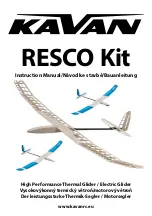
7
We recommend that you try the correct fitting of the acceleration system
on equipment designed to do this, most paragliding schools have this
sort of equipment.
2.6 INSPECTION AND WING INFLATION ON THE GROUND
Once you have checked all the equipment and made sure that the wind
conditions are favorable, inflate your IKUMA as many times as necessary
in order to become acquainted with the wing’s behavior. The IKUMA
inflates easily and smoothly. An excess of energy is not necessary and
the wing will inflate with minimum pressure on the harness when you
move forward. This may be assisted by using the A lines. Do not pull on
them; just accompany the natural rising movement of the wing. Once the
wing is in the 12 o’clock position, simply apply correct pressure on the
brake lines and the IKUMA will sit over your head.
2.7 ADJUSTING THE BRAKES
The length of the main brake lines is adjusted at the factory to the length
established during certification. However, the length can be changed to
adapt to the pilot’s flying style. Nevertheless, we recommend that you
fly for a while with these, set at the original length. This will allow you to
become accustomed to the IKUMA and its unique flying behavior. If you
then decide to change the length of the brake lines, untie the knot, slide
the line through the brake link to the desired length, and strongly re-tie
the knot. Qualified personnel should carry out this adjustment. You must
ensure that this adjustment does not slow down the glider without any
pilot input. Both brake lines should be symmetrical and measure the same
length. The most recommended knots are the clove hitch knot or bowline
knot.
When changing the brakes length, it is necessary to check that they do not
act when the accelerator is used. When we accelerate the glider rotates
over the C riser and the trailing edge elevates. We must check that the
brake is adjusted taking in consideration this extra length in acceleration.
3. THE FIRST FLIGHT
3.1 CHOOSE THE RIGHT PLACE
We recommend that the first flight with your IKUMA is made on a smooth
slope (a school slope) or in your usual flying area.
3.2 PREPARATION
Repeat the procedures detailed in chapter 2 UNPACKING AND
ASSEMBLY in order to prepare your equipment.
3.3 FLIGHT PLAN
Draw out a flight plan before take-off in order to avoid possible flight
errors.
3.4 PRE-FLIGHT CHECK LIST
Once you are ready, but before you take-off, carry out another equipment
inspection. Ensure correct installation of all equipment and that all lines are
free of hindrances or knots. Check that the weather conditions are suited
for your flying skills.
3.5 WING INFLATION, CONTROL AND TAKE-OFF
Smoothly and progressively inflate the wing (chapter 2.6 INSPECTION
AND WING INFLATION ON THE GROUND). The IKUMA inflates easily
and does not require excessive energy. It does not tend to over-take you,
so the wing inflation phase is carried out without anguish. These take off
characteristics provide a perfect control phase and enough time for the
pilot to decide whether to accelerate and take off.
Whenever the wind speed allows it, we recommend a reverse launch
technique; this type of launch allows you to carry out a better visual
Summary of Contents for IKUMA 21
Page 1: ...USER S MANUAL IKUMA...
Page 17: ...10 3 RISERS ARRANGEMENT 17...








































